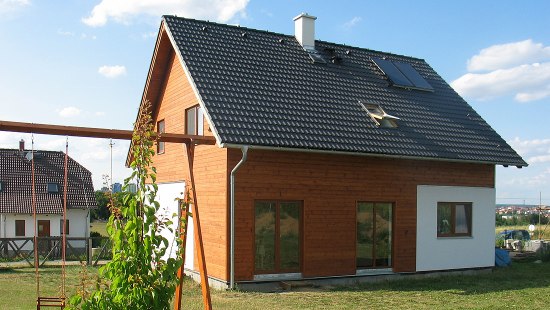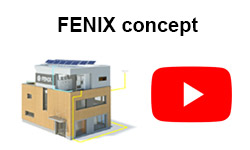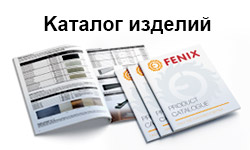Heating in a Detached House in Pilsen

House and Household Characteristics
Low-energy wooden house in energy category “B”. The house is standing at the outskirts of Pilsen, in a newly built housing area. It is a two-storey building of a total residential area of 158.37 m²: 1st floor - 78.86 m², 2nd floor - 79.51 m².
The house came into service in November 2009 and it has been fully used by the family since then. The house is occupied by a family of five; three children, wife is on maternity leave at present (2009-2010); it means the kitchen is used all-day long.
The household only uses one type of power to run the house - electric power; the house is equipped with standard electric appliances, including a drier requiring 2300 W power demand. For cooking, the kitchen has an induction cooktop. Hot utility water is heated by two electric boilers: one for kitchen of a 20-litre volume (located near the sink) and one for bathroom of 200-litre capacity. This boiler is combined with a solar source of 3.56 m².
The residential space counts with hot-air fireplace (without hot air distribution to all rooms) to be constructed in the future. The house does not have a recuperation unit; it is ventilated classically through windows. Currently, ladder heating is not installed in bathrooms.
The principal circuit breaker is fitted with 3x25 A. Before switchboard was mounted, special attention was paid to even load distribution of each phase. Well-thought even phase load has an impact on the choice of optimum value of the principal circuit breaker or assembly of an electric current load alleviator; this fact affects operating economy of the household and it is the principal indicator showing that home switchboard is to be installed.
Originally, the investor wanted to fit an electric current load alleviator, type HJ 306, that disconnects heating circuits in two priorities, if needed. Load alleviator has not been installed and current experience by the household indicates it is not needed. House rate for electric power consumption: D 45 - comfort; electric power is supplied by ČEZ.
Heating
Although it is a standard house from the architectonic perspective, the investor did not choose commonly used standard hot-water heating system. Electric power and large-area systems were chosen. The reason for this choice can be summed up to “5Ms” whereby the investor formulated his preferences for the heating of his house; as a bonus, the running is entirely automatic:
- Minimize investment costs
- Minimize running costs
- Miinimize or eliminate costs of maintenance and servicing
- Maximize heat supply comfort
- Maximize service life of the system, including guarantee period
Having evaluated options available at the market, large-area systems ECOFLOOR and ECOFILM were selected in the following combination: on the fist floor and in second-floor bathroom, atypical cable mats ECOFLOOR, type PSV; there is only one standard mat in first-floor bathroom, type LDTS. Heating foils ECOFILM, type C, are installed on the second floor, under the plasterboard ceiling structure.
Investment costs of the heating technology are evident from the table below. Costs of the material of electric piping and other electric wiring components were included in total electric wiring costs and were not monitored separately. Heating technology was installed by the investor himself.
| Calculated thermal loss by each room | proportion ECOFLOOR system | proportion ECOFILM system | Total installed output and price | |||
|---|---|---|---|---|---|---|
| Qc (W) | W | CZK excl. VAT | W | CZK excl. VAT | W | CZk excl. VAT |
| 5613 | 4210 | 22,869.00 | 2960 | 14,186.00 | 7170 | 37,055.00 |
Both heating technology systems ECOFLOOR and ECOFILM have been installed into floor or ceiling structure, respectively. There are zero requirements for special maintenance; maintenance and servicing is the same as in standard home electric installations.
User comfort of the heat supply results from the functions of selected large-area systems ECOFLOOR and ECOFILM. In classic central heating where hot-water radiator is the source of heat in the room, heat is distributed from one high-temperature place from which heat is spread by means of hot-air circulation and the room is heated from the ceiling downwards (the same applies to most electric wall appliances). Since heating has to do with feelings, we only feel comfortable in a room when required comfort temperature is felt at the floor because we are most sensitive to heat at our feet. However, such systems achieve the highest temperature at the ceiling where it is absolutely useless. To achieve the required comfort temperature at the floor, the room must be “overheated” but this is certainly not desirable at all from the economic perspective. This negative aspect is entirely eliminated by large-area floor and ceiling systems that guarantee even distribution of temperatures at both horizontal and vertical levels of the room. This temperature evenness is one of the main reasons of high heating comfort, above all in systems of direct electric heating while maintaining low running costs. The floor heating system, very pleasant especially in the so-called cold floor covering, such as paving or laminate floating flooring, etc., is quite widely used at present and it has become a standard solution nowadays, above all in bathrooms. The ECOFLOOR program offers a whole range of product groups and forms the largest offer at the market. The difference from hot-water floor heating consists, above all, in very low investment costs of technology and implementation.
On the first floor, floor structure is installed by the so-called wet process - the supporting board is grouted from anhydrite self-nivelling substance. Therefore, electric cable mats ECOFLOOR have been used to heat the first floor. Atypical cable mats were selected out of the assortment offered because they are easy and fast to be laid. The heating mats were supplied for each room in optimum area outputs; and their dimensions and shapes copied the perimeter of the room (only areas under permanently fitted appliances or installations were skipped). A standard cable mat was only used in the bathroom.
On the second floor, the floor structure is made of wood and therefore the designer proposed electric ceiling heating by means of the ECOFILM system. The system works on the principle of the so-called infrared heating, i.e. it is a highly efficient system similar to sunshine, heating primarily objects and not the air. As a source, it uses electric heating foils ECOFILM, type C, installed under the plasterboard ceiling structure. Heating foil ECOFILM radiates infrared beams through the plasterboard down to the floor; the beams are absorbed by objects, including persons, and not transformed into thermal energy until touching the objects. This modern technology guarantees that heat is always created where it is most needed.
The output needed is installed by a certain number and length of different stripes of the ECOFILM foil, interconnected mutually by conductors. Length and number of the stripes and their area or length capacity were designed in such a way so that their heat flow would provide optimum shading for cold radiation of peripheral and roof structures in the room and so that it would cover the living area to maximum extent, to provide for even heating of the area. The bathroom makes use of atypical cable mat ECOFLOOR to provide for warm paving comfort that has crucial sense in bathrooms, above all, and it is not only comfortable but also practical because it makes wet floor get dry fast.
he house has two roof windows. To prevent the windows from getting wet with dew, electric heating foils ECOFILM were installed to inclined plasterboard window sills, type F, output 300 W/m2. Output installed under every window: 45 W. The foils may be switched on by a switch, independently of the heating regulation. Owing to the fact that electric heating mats are laid in the living room to reach as far as the French windows, there was no need to install a special device to prevent French windows from getting wet with dew; the heat flow rising from the floor is sufficient.
Both systems ECOFLOOR and ECOFILM are provided with a standard guarantee of 10 years. Their service life is comparable to the service life of constructional structures.
Regulation
Heating is regulated, as a temporary solution, by means of room thermostats EuroThermo 099-ECO2, fitted in every room. Before next heating season starts, central regulation of own production will be installed, permitting to read consumption and running duration of the heat technology in each room in detail. Basic information will be provided after regulation is installed.
The household watches closely its amount of power consumed. The house has been in use since November 2009. but it included virtually the entire heating season. In 2010, the billing period shifted the contrary, therefore accounts for the year 2010 represents the entire 15 months of operation the household.
| Period | Consumption | CZK icluding DPH | |
|---|---|---|---|
| NT (kWh) | VT (kWh) | ||
| 11/2009 - 04/2010 (5 months) | 6 016 | 412 | 17 144 |
| 04/2010 - 07/2011 (15 months) | 9 718 | 550 | 29 910 |
| 07/2011 - 07/2012 | 8 249 | 468 | 26 723 |
| 07/2012 - 07/2013 | 9 295 | 573 | 31 254 |
| 07/2013 - 07/2014 | 7 962 | 585 | 26 537 |
| 07/2014 - 07/2015 | 8 376 | 613 | 25 875 |
| 07/2015 - 07/2016 | 8 211 | 568 | 25 583 |
| 07/2016 - 07/2017 | 9 172 | 589 | 27 983 |
| 07/2017 - 07/2018 | 8 468 | 647 | 24 798 |
| 07/2018 - 07/2019 | 8 004 | 698 | 24 074 |
| 07/2019 - 07/2020 | 7 678 | 680 | 23 794 |
| 07/2020 - 07/2021 | 9 395 | 745 | 35 827 |
| 07/2021 - 07/2022 | 7 844 | 691 | 31 939 |
| 07/2022 - 07/2023 | 7 293 | 631 | 26 272 |























